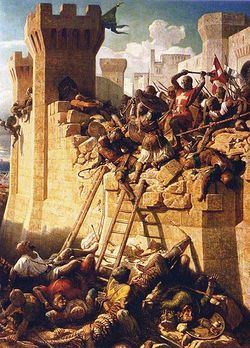Difference between revisions of "Siege of Helena"
m |
Brotherbot (talk | contribs) m (→Aftermath: Cleaning up typos) |
||
| Line 77: | Line 77: | ||
| − | [[Category: Battles]] | + | [[Category:Battles]] |
A small period was claimed by the Renatian force to lick their wounds and recover from the gruelling siege that had ensued. The victory of this siege had led to the turning point in the [[War of Two Emperors]], allowing the [[Empire of Renatus]] to further solidify their winning position in the war both politically and numerically. | A small period was claimed by the Renatian force to lick their wounds and recover from the gruelling siege that had ensued. The victory of this siege had led to the turning point in the [[War of Two Emperors]], allowing the [[Empire of Renatus]] to further solidify their winning position in the war both politically and numerically. | ||
Revision as of 07:22, 13 May 2020
|
The Siege of Helena was the siege of the Renatian capital in the second year of the War of Two Emperors resulting in a pyrrhic Renatian victory, having been able to repel the invaders at great cost.
Prelude
As the Renatian regime built their megafortress of Loches, Orenian army commanders were not caught unawares. Oren and its allies would march through the historically neutral Cloud Temple and its generally uninhabited forests to arrive at the gates of Helena itself, skirting the defenses. Renatus, left with no further options, hastily recalled William Jrent and Robert d'Anpalais from Fort Loches to help plan a patchwork defense of sand pits, trenches, and archer galleries in and around the Imperial Palace and the city's main causeway. Just as they neared completion, the Orenian army and their siege weaponry arrived at Helena Fields.
Battle
After a short round of misfires on the part of Orenian trebuchets, and with the assistance of Haeseni sappers, the raised drawbridge of Helena was detached and a route opened for a battering ram. The great majority of Orenian siege weaponry then aimed at the Imperial Palace, blasting its roofing, and its frontal entrance, to shreds. For hours the Orenians would meticulously sweep the city in search of Renatian soldiers hiding among the citizenry before the high command sounded the order to ready a charge on the seat of Renatus. Up until this point various Fennic skirmishing units, alongside their Reiver counterparts, trepased amongst the roofs of the city to exchange arrow fire with the stationed Renatian army - which was held atop the now flattened roof of the Imperial Palace.
So far, there was minimal losses on either side save a few lives taken by trebuchet or arrow-fire, and it fast-apparent that the Renatian Legion was centering itself in a tight circle in and around the Imperial Palace. Bracing themselves for an Orenian charge as the front-entrance to the palace, and the make-shift constructs a front of it had been blown asunder by heavy trebuchet bombardment. Eventually, a large horn blared throughout the tense air and the Orenian army charged en masse, aiming to force their way into the Imperial Palace. When around half of the Orenian forces had breached the palace gates, largely uncontested, the Renatian commander, Martinus Horen, ordered his own army to drop down from the palace-roof on to the Orenian army below - effectively cutting them in half.
In and around the ruins of the intricate Gates of the Bastard Dragon and Dragon Empress, it is said a combined twenty thousand men died, their limp bodies forming new barricades for the weary defenders. For many hours, it seemed as though the Orenian soldiers had gained the upper-hand due to their vast numerical advantage over the defenders, after long hours of fighting both forces synonymously pulled back their forces to regroup - with about two-thousand defenders retreating behind the rubble of the palace gates; the Orenians had mustered a regroup of about double that.
So, as the numbers of both sides dwindled to a quarter of their original size - yet Oren still had the numerical advantage of 2:1, the Orenian commanders issued the order to charge once more, and the numerically superior forces that entered were repelled by the elite soldiers Renatus had tasked with forming a final line of defense within the throne room, including such figures as Ser Aldis Chase and the one-handed Martinus Horen. At the end of this last engagement, stood-atop the corpses were a mere 400 hundred soldiers that had survived the whole ordeal without being greatly injured - or dead.
With supplies from the elongated route and usable divisions dwindling, Joseph I sounded a general retreat from the city, allowing Renatus brief respite before its own offensive. In the meantime, the Haelournian med-corps scoured through the city - treating to all wounded with haste.
Aftermath
A small period was claimed by the Renatian force to lick their wounds and recover from the gruelling siege that had ensued. The victory of this siege had led to the turning point in the War of Two Emperors, allowing the Empire of Renatus to further solidify their winning position in the war both politically and numerically.
This siege should also mark the acknowledgements of some of the Renatian Greats of the Era, such as Martinus Horen, Adeline Horen, Octavian Horen, Robert d’Anpalais, William Jrent, Donald Dabber, etc. - who all contributed to a historic military campaign.
To this day, it is one of the largest conflicts that has ever occurred in history; documented as an unbelievable shock victory for the Empire of Renatus who claimed victory in extremely unfavourable conditions while being vastly outnumbered. It also would mark the end of Renatus, for after decades of war and conquests - the living “Hero’s of Renatus” retired to their various estates scattered amongst the known world.
((225 vs 175))
